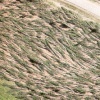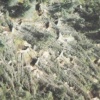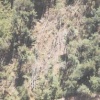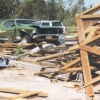Independence Day 1977 Downbursts
On July 4, 1977, a severe thunderstorm complex moved across
northern Wisconsin, and produced extreme damage to trees and properties. The hardest hit
areas included Sawyer, Price and Oneida counties. Burnett, Washburn, northeast
Rusk and northern Lincoln counties were also affected by the severe storm.
The damage was described like that of an oversized tornado. In fact, the
166
mile long and up to 17 mile wide swath of damage was caused by straight-line
winds of the thunderstorm complex, that first hit at about 1:15 pm (CDT). Winds likely
exceeded 115 mph in Sawyer county. A large section of the Flambeau State Forest,
including trees four feet in diameter, were flattened. One person was killed in
a camper and eight injuries were reported in Sawyer county.
The city of Phillips in Price county was especially hard hit. Thirty homes were
destroyed and most buildings in the area sustained some damage. An anemometer at
the Phillips airport recorded a 100 mph wind before it blew away. In Price
county alone, 172,000 acres of forest was destroyed or badly damaged. Twenty
injuries were reported in the county.
In Oneida county, eight homes were badly damaged and seven injuries were
reported. The winds reached 100 mph at the Rhinelander airport at about 3:30 pm
before the instruments blew away. 200,000 acres of forest sustained damage in
Oneida county.
The ferocious storm resulted in over $24 million in damage (1977 dollars), one
death and 35 injuries.
The storm damage from the July 4, 1977 storm was intensely researched by the
world renowned tornado researcher, Dr. Ted Fujita. Through his studies of this
and similar storms in the late 1970s, Fujita was able to prove his theory that
thunderstorm "downbursts" could cause considerable damage near and at the
ground, and pose a significant hazard to aircraft.
Click on small images below for larger view.
Radar
|
|
Analysis of the July 4, 1977 radar imagery showing the evolution of a a classic bow echo. Times are in CST (add one hour for CDT). |
 |
Radar imagery from July 4, 1977. Times are CST. |
The Damage
References:
"The Downburst," 1985, T. T. Fujita, published by the University
of Chicago, Chicago, Illinois.
"The Storm...July 4, 1977," 1978, B. Slowey, published by Phillips High School,
Phillips, Wisconsin.
This page was developed by Jeff Last (jeff.last@noaa.gov),
Warning Coordination Meteorologist - 6/27/02




